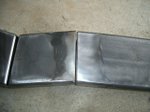Buy and Hold
Another tool in the bag of the Real Estate Investor is the "buy and hold option. Buying and holding a property is a longer term strategy. In this case, one is using the increase in values over time, generally in conjunction with rental income, to increase their personal wealth. The renter is the key to this being a hugely profitable strategy. An example of this would be:
$200,000- purchase price ($40k cash, $160k mortgage)
$485,000- selling price (after 30 years at a conservative 3%/yr.)
$1,500/mo.- carrying cost (this will go up slightly as taxes and insurance increase)
$1,600/mo.- rent (first year)
* A note about the rent: I would rent to the "right tenant at a discount to keep them longer term. Also, the rent, which will increase around the same as property values over time will go from $1600 in the first year to $3900 in the 30th year. Keep in mind that while the carrying cost will go up, they won’t go up nearly at the same rate as the rent.
While there are a few things to plan for, such as repairs, upgrades and time without renters, if one held the property for 30 years, they would have a property worth almost $500,000 with no mortgage. I would feel confident in saying that the cash flow from the rents (especially as they increase) will cover any expenses in the long term. Compare this to a 6% return on the down payment from a mutual fund, and the $40k down payment would possibly yield $230k.
$200,000- purchase price ($40k cash, $160k mortgage)
$485,000- selling price (after 30 years at a conservative 3%/yr.)
$1,500/mo.- carrying cost (this will go up slightly as taxes and insurance increase)
$1,600/mo.- rent (first year)
* A note about the rent: I would rent to the "right tenant at a discount to keep them longer term. Also, the rent, which will increase around the same as property values over time will go from $1600 in the first year to $3900 in the 30th year. Keep in mind that while the carrying cost will go up, they won’t go up nearly at the same rate as the rent.
While there are a few things to plan for, such as repairs, upgrades and time without renters, if one held the property for 30 years, they would have a property worth almost $500,000 with no mortgage. I would feel confident in saying that the cash flow from the rents (especially as they increase) will cover any expenses in the long term. Compare this to a 6% return on the down payment from a mutual fund, and the $40k down payment would possibly yield $230k.
Shifting classes
Either of these strategies can be used with both commercial and residential properties, as well as undeveloped land. The property may also be shifted from one class to another. Land can be flipped by building a home (residential) or shopping center or warehouse (commercial). A warehouse type of building may be renovated into loft apartments (B&H, and residential) or sold as loft condos (flipped). A home on a busy street may be renovated to offices and be re-zoned commercial and either rented or sold. Obviously there are a lot of variations that can be employed.But what about for a different budget?
Also, the price and financial commitment can be varied as well. Condos ready to be flipped often come on the market at prices well under $100k, and occasionally as low as $50k. A $15k investment may be able to yield a $25k or $30k return. Also, one can partner with others looking to do the same type of investment and form a partnership. This arrangement adds complexity, but also spreads the risk.
Lastly, remember to talk with your accountant and/or tax preparer about the tax ramifications of these types of investments. One may be able to employ deductions and credits to lower their tax liabilities from their investments. If you have any questions, or would like to get started in real estate investing, please feel free to contact me.









No comments:
Post a Comment